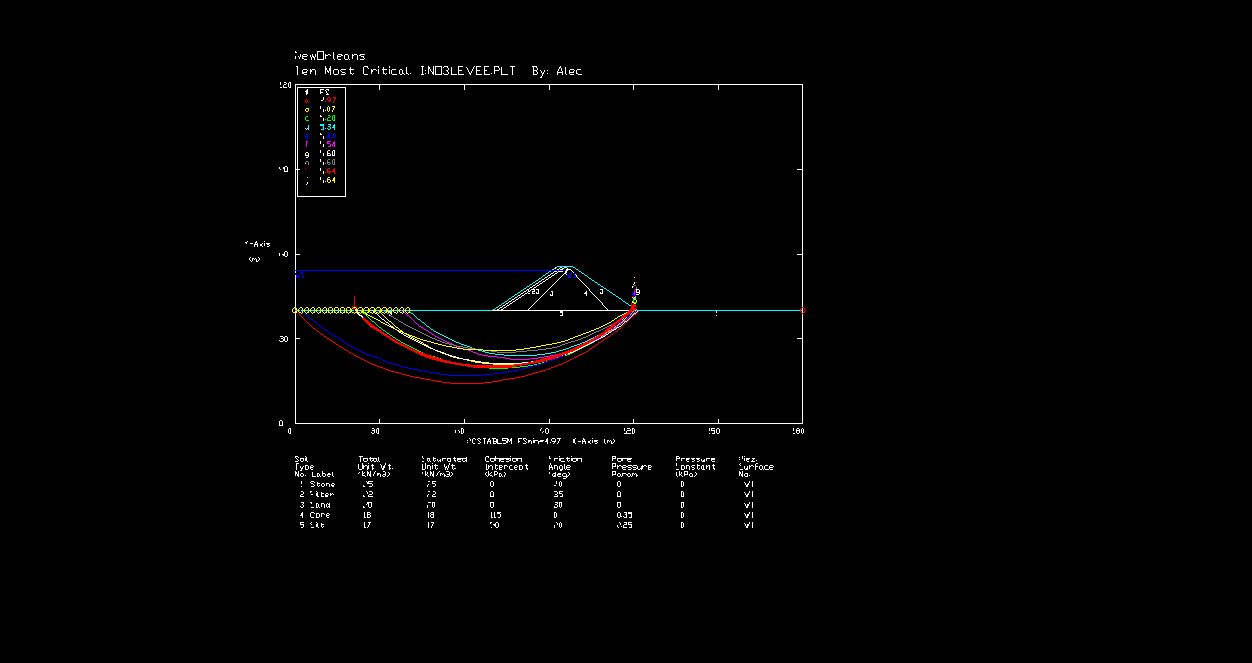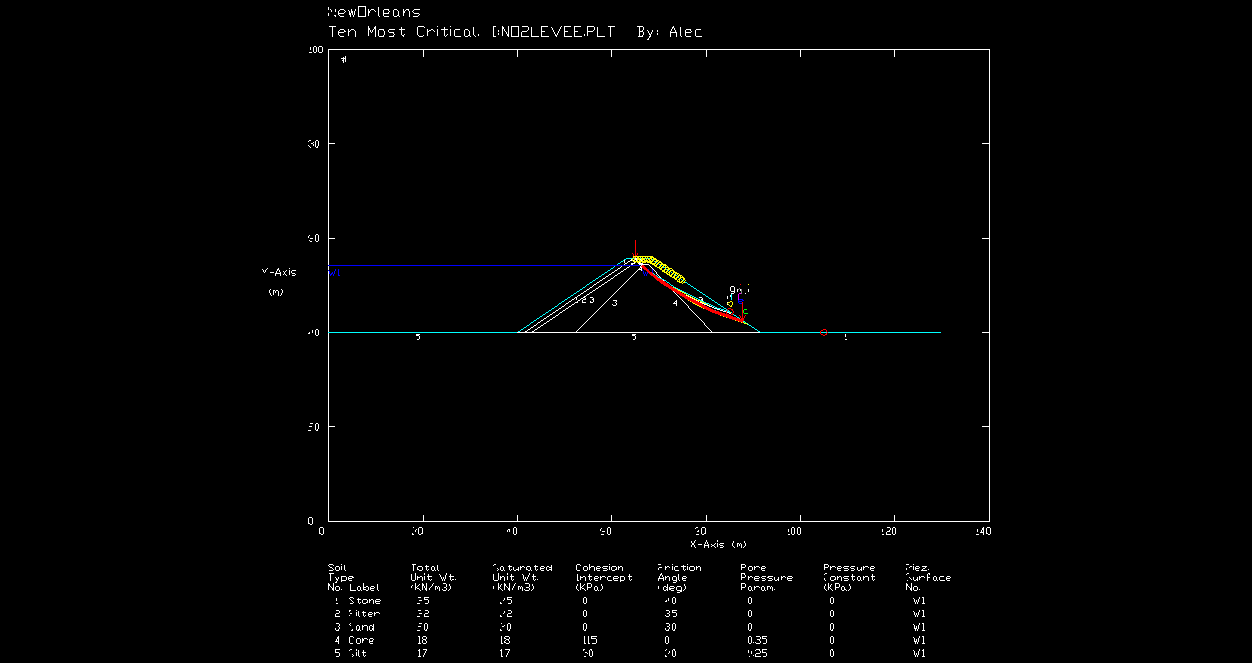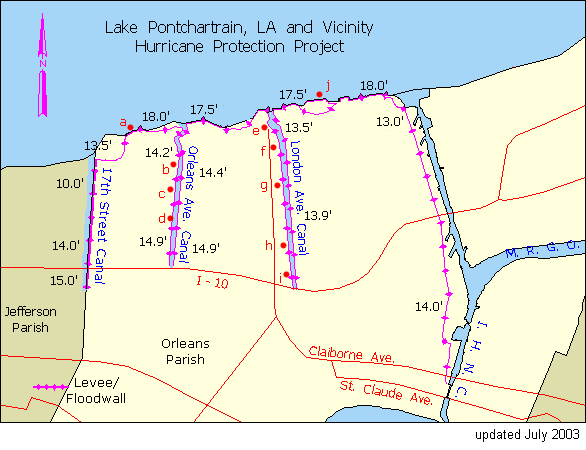Theoretical Levee Design for a Category
5 Hurricane in
Alec Danielson
CEE 514
Introduction
Motivation
After watching the destruction of Hurricane Katrina on the news and listening to analysis about how New Orleans wasn’t prepared for a large hurricane, I wanted to design one of the levees that failed in New Orleans for a category 5 hurricane and see how much different it would be to the levee that was already in place. I wanted to see if my design was more robust, and I wanted to analyze some of the many aspects that go into designing a coastal structure.
Disclaimer
The analysis and design provided in this webpage are done using many simplified assumptions. There are too many conditions to consider that I do not have the expertise in to perform a complete analysis. I focused on the major design issues while still trying to account for the other potential issues.
Site Description
I chose to analyze the levees that failed near downtown
![]()

Figure 1 – Map of Lake Pontchartrain Arrow designates site location (Wikipedia 2005)

Figure 2 – Picture of
near-shore bathymetry in Lake Pontchartrain The circular
depressions represent the areas of dredging common near the shore of New
![]() Major Assumptions
Made
Major Assumptions
Made
I made numerous assumptions to simplify the problem including:
à Category 5 Hurricane (Wind Speeds 70m/s or 155 mph) See Saffir Simpson Scale below
à Storm lasted 6 hours (approximately the duration of a major storm for a single location)
à Fetch of 3200 meters (this was approximated using an east to west wind provided by a hurricane and the protection provided by land near the site location)
à Storm doesn’t weaken during the duration

Figure 3 – Saffir Simpson Hurricane Scale Note that calculations were made using the lower limit of a Category 5 hurricane (155mph) (duedall.fit.edu)
Analysis
Storm Surge Calculation
Storm surge calculations were made using the closed basin analytical approach. The assumption of a straight-line wind was used over the distance of 3200 meters. Calculations were made along different depth segment to account for seafloor variability. Sample calculation is shown below.
∆d/∆x = Cd*U102 / g*d
where ∆d = change in water depth from wind set-up
∆x = distance traveled
U10 = Wind Speed
g = acceleration due to gravity
d = water depth
Cd = Drag Coefficient
where Cd = (1.21 + 2.25(1-5.6/U10)2) x 10-6
for U10 = 70m/s, d = 5m, ∆x = 32000m (rough approximation of problem)
∆d = 10m
Full segmented analysis was conducted on a spreadsheet with the following results


Figure 4 – Storm Surge Calculated for distance traveled Notice the linear increase in storm surge with depth until the near shore, where the dredging pits decrease the incremental storm surge
The total wind induced storm surge calculated was 8.7 meters (~28ft)
Wind Generated Waves
The JONSWAP method for calculating wind generated waves was used with the same assumptions (U = 70m/s, 6 hrs duration) used to calculate the storm surge. It was determined that the waves were fetch limited. Fetch limited means that the length of water over which wind can generate waves is limiting the development rather than the duration for which the wind has blown over the water. The complete analysis was performed in segments to see the change in wave height with the distance traveled. A sample calculation using the JONSWAP method is shown below.
1st step – calculate F* F* = gF/U102
2nd step – calculate t* t* = gtd/U10
3rd step – calculate F*eff F*eff = (t*/68.8)^1.5
4th step – compare F* & F*eff if F* > F*eff ~ duration limited
if F* < F*eff ~ fetch limited
use smaller value for F**
5th step – calculate Hs gHs/U102 =
0.0016(F**)^0.5
6th step – calculate Tp gTp/U10 = 0.286(F**)^1/3
where F = fetch length
Hs = Significant Wave Height
Tp = Wave Period
td = duration

Figure 5 – Wave
Height Calculations using the JONSWAP method Notice the slower increasing wave height with distance traveled indicating
that the waves are becoming closer to fully developed
The wave heights calculated above using the JONSWAP method
did not account for interaction with the lake bottom. The waves generated are very large and very
long and

Figure 6 –
Dimensionless wave height versus relative depth For shallow water conditions the wave height is limited to ~0.9Ho. Shallow water conditions exist for much of

Figure 7 – Water
Height Envelope Notice the increasing
differences between the maximum and minimum wave heights with distance
traveled.
Wave Run-up
With the incident storm surge and wave heights calculated the interaction with the levee must be considered. The design height of the levee depends not only on the storm surge and the wave heights, but also the wave run-up caused by the incident wave energy. Wave run-up is the dissipation of the wave energy after the wave breaks, and is a function of: deep water wave height and period, the surface slope, approaching depth, and roughness and permeability of the slope. Dimensionless analysis with a run-up factor of 0.5 (stone) was used for 3 different potential slopes. The permeability of a stone slope diminishes the run-up expected on a smooth impermeable slope by the factor of 0.5. The sensitivity of the wave run-up to slope angle can be seen by the calculations for the 3 different slopes. The slopes chosen were: 1.5H/1V, 2H/1V, and 2.5H/1V. These slopes are common slopes used in embankment design. The process for calculating wave run-up is described below.
Calculate Ho/gT2
with Ho/gT2 known use Figure 7 to determine wave run-up
Ho/gT2 = 6.08/(9.81*8.152) = 0.0093
from Figure 7 cot(1.5) R/Ho = 2 using the run-up factor of 0.5; R = Ho = 6.08
cot(2) R/Ho = 1.5 using the run-up factor of 0.5; R = 0.75Ho = 4.56
cot(2.5) R/Ho = 1.3 using the run-up factor of 0.5; R = 0.65Ho = 3.95

Figure 8 –
Dimensionless run-up chart Run-up
increases with increasing angle until the 1.5H/1V point. Any slope steeper than 1.5H/1V has less run-up
and greater reflection
Wave run-up is the vertical distance from the average wave height. My calculated values gave a run-up that was equal to the wave height for the 1.5H/1V slope and run-ups that were smaller for the shallower slopes. The small values of run-up can be attributed to the permeability of the stone slope. Because the wave amplitude (H/2) and run-up are measured from the same datum, the larger of the 2 values is chosen for the design water level. With the storm surge, wave amplitude and run-up considered the design water level is:
∆d(tot) = ∆d(storm surge) + [∆d(wave
amplitude) < ∆d(run-up)]
∆d(tot) = ∆d(storm surge) + ∆d(run-up) = 8.07 + 6.08 = 14.15m for 1.5H/1V
= 8.07 + 4.56 = 12.63m for 2H/1V
= 8.07 + 3.95 = 12.02m for 2.5H/1V
Design
The design was completed using similar designs as a blueprint and analyzing some of the site specific parameters. I selected a embankment earth dam as my preliminary design with varying slopes for the side walls. Shallower slopes have a shorter design height and should have more stable slopes while more inclined slopes would take up less land on the shoreline. I needed to select my materials before I completed any design.
Riprap Selection
The mass of the stones used for slope protection was determined using the Hudson Equation (see below)
M50 = ρr H10%3
Krr(ρr/ρw-1)3cotα
where M50 = mean stone mass
H10%=
top 10%
ρr = density of rocks
ρw = density of water
Krr = riprap stability coefficient Breaking waves Krr = 2.2 Krr = 2.5 for nonbreaking waves
M50 = (2550kg/m3*(6.08m)3) M50 = 747 kg
2.2*(2550kg/m3/1000kg/m3-1)3*2.5
A limited range for the gradation of the riprap has been empirically determined:
where Wmax = 4.0W50 -largest stones cannot weigh more than 4 times the average stone weight (determined above)
Wmin = 0.125W50 -smallest stones cannot weigh less than 8 times the average stone weight
The diameter of the stone was then determined from the following relationship
Ds
= 1.24(Ws/γs)3
Diameter of average stone was determined as
Ds = 1.24(( 747kg*9.81m/s2)/25kN/m3)^1/3 Ds = 0.824m
Similarly, the diameter of the smallest and largest stones were determined
Dmax = 1.308m
Dmin = 0.412m
Filter Selection
A filter layer is needed between riprap protection and sand fill to limit movement of the riprap and to prevent piping losses of the fill. The movement of riprap could occur, because of the extreme differences in size between the riprap and sand (the diameter of medium grained sand is ~0.2cm). Piping losses are when the movement of water forces particle movement in a earthen structure. The difference in size is once again the culprit for piping losses. An intermediate layer prevents the movement of the finer particles out of the structure. It has been empirically determined that the thickness of the filter layer should be twice the size of the diameter of the stone above. This equates to a filter layer thickness of 1.6m for my design.
The size of the filter is also determined empirically through the following relationship:
d15(filter) < 4*d85(layer below)
Assuming d85 = 0.3cm
d15(filter) < 1.2cm àthis places the filter in the gravel range
The backfill material was determined to be medium grained sand and the core was deemed to be a loam. Full material properties can be seen on Figure 7.
Bearing Capacity Analysis
With the general design of a core earthen embankment set, I
tested the potential bearing capacity failure of the designs under the 3
different slopes. A bearing capacity
failure could result in movement of the entire embankment. If a section of the embankment moved relative
to the rest of the embankment, cracks could form and the levee would be in
jeopardy. The potential for failure in this
mode exists, because of the loose silt that is characteristic of

Figure 9 – Bearing capacity analysis Results of the bearing capacity analysis show that failure in this mode is unlikely with FS = 4.7
Slope Stability Analysis
The slope stability of the embankment was analyzed to determine if failure along any of the interface slopes would occur. The slope stability was determined using the Bishop Circular Method in STED. All of the embankment designs had very large factors of safety for the embankment slopes. Slopes of 1.5H/1V are manageable slopes for granular material (riprap, gravel, sand) and it was determined that pore pressure in the core resulting from the wave heights was not sufficient to cause failure along the interface of the core and sand fill.

Figure 10 – Slope
Stability analysis Slopes were deemed
stable using the Bishop Circular Method
Seepage under the Embankment
I evaluated the seepage under the embankment using the principle of Darcy’s Law for flow through a porous media. I drew a flow net for the embankment under storm conditions. With the assumption of 0.5cm/s for the hydraulic conductivity of the silt under the dam I calculated the following seepage under the embankment.
Darcy’s Law Q = kiA
for a flownet Q/A = q =Nf/Nd*k
where q = specific discharge = flow per unit area
Nf = number of flow tubes = taken from the flow net = 6
Nd = number of head drops = head difference between the 2 sides of the embankment = 14.14 m
k = hydraulic conductivity = 0.5cm/s
q = 0.5 cm/s * (6/14) * 1m/100cm = 0.0024 m/s = 7.7 m/hr = 46 m/6hr storm
The seepage under the embankment is considerable. Foundation preparation in the form of a sheet
pile or grouting would be necessitated for an effective design. For the calculated specific discharge, 46
cubic meters of water would pass under the embankment for every linear foot
along the embankment. Seepage would
greatly contribute to the flooding problem associated with large storms in
Other Design Options
Several other options exist for levee design. A seawall can be built, with or without
tiebacks, and a seawall can be used in combination with a levee. A seawall by itself would not be the preferred
option for this purpose, because the seawall would have to be extremely high to
meet the design wave height.

Figure 11 – T-type seawall
that can be used with a levee or separately.
Selected Design
After analysis of the earthen embankment design and investigation of other design options, I chose the 1.5H/1V core earthen embankment design. All of the earthen embankment designs that I examined were very robust as would be expected for such an extreme design. The 1.5H/1V earthen embankment design was chosen, because it took less shoreline space, and would require fewer materials to build. This design is still very large and would require a large quantity of earth materials. The loam used to make the core would be compacted 5% wet of optimum. This is a value that has proven to be effective in numerous designs. The selection of sand for the backfill is not critical and would be taken from the nearest source. Riprap and gravel used for slope protection and the filter would be selected from the nearest source that meets the predetermined design requirements.
Comparison to Actual Levees
The levees in

Figure 12 – Levee heights
along Lake Pontchartrain in
To check my analysis of water level fluctuations I chose to
recalculate my design wave height for a category 3 hurricane and compare my
design height to that of the USACE’s. The storm surge calculated using the same
method was 4.3m, with an additional wave height of 2.3m. My theoretical design water level for a
category 3 hurricane is therefore 6.6m or ~21ft. Using my methods I calculated a design height
that was about 1m higher than the USACE’s. The design completed by the USACE is much
more in depth and complete, but I validated my approximation of a theoretical
levee design for a category 5 hurricane in
Sources
J.R. Compton and S.J. Johnson, "Earth and
Rock-Fill Dams General Design and Construction Considerations," Department
of the Army Corps of Engineers., Washington, D.C. 20314, Tech. Rep. EM
1110-2-2300, 1971, 1971.
A.L. Goldin and L.N. Rasskazov, Design of Earth Dams,
R.M. Sorensen, Basic Coastal Engineering,
US Army Corps of Engineers, "Retaining and Flood Walls," Army Corps of Engineers., Washington, D.C. 20314, Tech. Rep. EM 1110-2-2502, 1989, 1989.
Coastal Engineering Manual, Army Corps of Engineering
Chin Wu, Phd